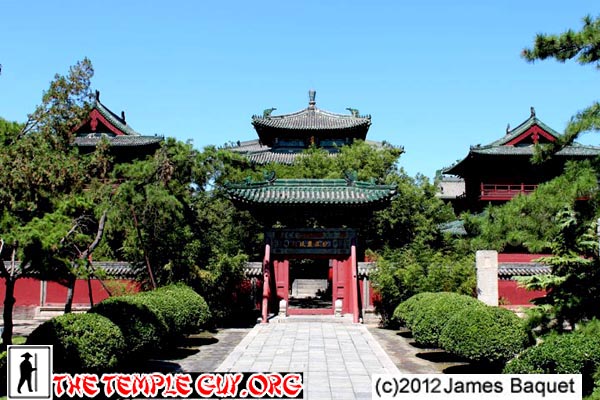(1) Here's the front gate of Longxing (Dafo) Temple. Knowing my trip to Zhaoxian would cause me to fly from Zhengding, and having read lots about the wonders of this place, I decided to make a visit.
I had actually been near last year: it's less than a kilometer away from where "Carey" sang "You Are My Sunshine" to me but I didn't go the extra distance to visit, mainly because of time.
I'm glad I made the time this time. Although no longer a working temple, it has one of the best collections of monumental statuary--gathered from other defunct temples in the area-- I've seen anywhere (hence the nickname Dafo or "Big Buddha Temple"). It made for a very relaxing last day of the trip. (I was carrying all my luggage, but as a 50rmb tourist destination, they had an office where I could leave it.)
(2) The l-o-n-g view to the first hall. Actually, in between, there used to be another...
(3) ...the "Hall of Shakyamuni's Six Teachers" used to be here. Note the orphanage for homeless statues along the base of the platform.
(4) The first hall (after the Heavenly Kings' Gate) is dedicated to Shakyamuni; because of a translational error (the Chinese name is "Moni Dian"), it's labeled the "Manichaean Hall."
(5) Inside are five "clay" figures (incorrectly called "five Buddhas" on the sign), Shakyamuni with Ananda and kasyapa, and the Bodhisattvas Puxian and Wenshu. The hall dates to 1052; no date is given for the statues.
(6) Behind is this stunning "suspended" Guanyin, flanked by a lion and an elephant (symbols of Wenshu and Puxian). This is part of a much bigger sculpture with numerous figures, and is dated 1563.
(7) The hall also has amazing, faded murals all over. I wish I could have spent time shooting them all, with a tripod and good lighting.
(8) Looking to the next compound, where numerous halls filled with wonders reside.
(9) The first central hall behind that gate is labeled "Buddhist Altar" and has two figures seated back-to-back: Amitabha and the Medicine Buddha, cast together in 1493.
(10) Detail of one of the side halls
(11) The left-hand side hall contains this rotating scripture cabinet (compare to the one at Tayuan on Wutai Shan), built "in the Northern Song Dynasty" (960–1127) and restored repeatedly.
(12) On the right is this colossal, brightly-colored Maitreya, 7.4 meters tall and said to be carved from a single piece of wood, in the Northern Song.
(13) Even the bixi (dragon/turtles with steles on their backs) were huge here.
(14) This is the "Pavilion of Great Benevolence" built around 972 and housing a huge Guanyin statue.
(15) And here it is, so high that in fact the building has a staircase made so you can see all of it (unfortunately closed). Built around the same time as the hall, the statue's two-toned colors are hard to make out--a trick of light? fading? Hard to say.
(16) In front of that hall, these guys were lounging around--until a busload of tourists showed up, then they swung into action--high-class busking.
(17) The next hall, built in 1510, is dedicated to Amitabha, and doesn't look so stupendous from the outside--but it turned out to be my favorite.
(18) OK, this is nice enough. Note the Bodhisattvas above and to the side? They're Dashizi and Guanyin, making this into a "Three Saints of the East" triad.
(19) But the real treasures of this hall were the handful of statues seemingly haphazardly placed around its walls. Note the gaps that have developed in the hollow bronze Buddha, and the way the Guanyin just leans against the wall (his/her seat is missing).
(20) A truly magnificent figure
(21) Close up on the previous image of Guanyin
(22) And this! Ah... Called "Royal Ease Guanyin," he/she really does seem to be in his/her element.
(23) The last hall in the temple is dedicated to Vairochana, my favorite.
(24) The image is almost like a totem pole.
(25) Close up on the four Vairochanas
(26) To the west of the Vairochana hall, was a small building containing something labeled only "Song tomb." Very intriguing.
(27) Now we're in the "Longteng Garden," located on the north and east sides of the temple grounds. Confession: When I saw this collection of "Stone Statues of Northern Dynasty," I exclaimed, "They have no heads!"--and burst into tears. (I felt pretty silly, I can tell you. But that's what happens on the pilgrim path--one becomes a little dotty.)
(28) My blues only intensified when I saw these fellows standing at the front of the headless audience. Only Ananda managed to keep his head. Look how fine the drapery and gestures are. What a loss.
(29) Drying my eyes, I moved on to this spring house, lined with beautiful small plaques (presumably brought from elsewhere).
(30) There's a lotus pond in front of the spring house.
(31) I seldom geek out on lotuses, but I was reluctant to leave this amazing temple, so I dawdled around for a few more shots.
(32) Leaving the temple, I took a taxi some 20 kilometers to the airport hotel. Here's a view of the airport from my hotel window (!) The next morning I flew back to Shenzhen; my Chinese pilgrimage has been on hold ever since, with just ten temples of the 142 to go!
| ← Previous Site | Back to Trip 19 Introduction | That's All, Folks! |
Last Updated August 21, 2019

































No comments:
Post a Comment